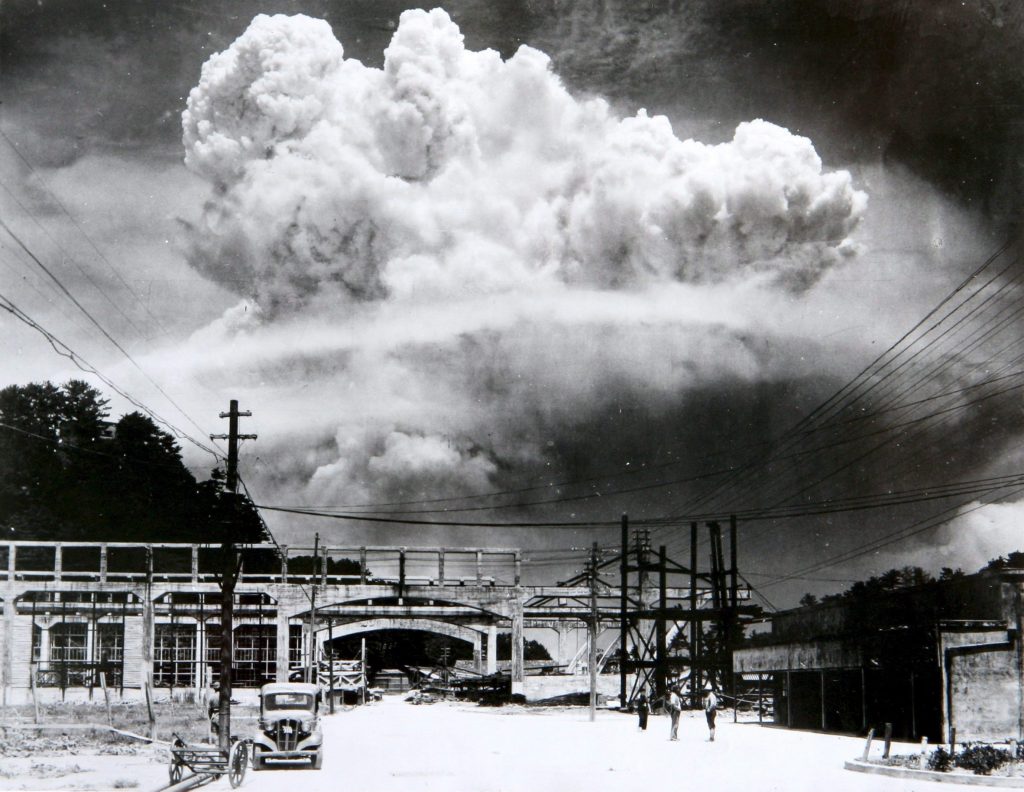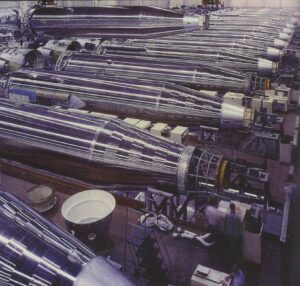August of 1945 marked grim days of apprehension for many cities across Japan. The Japanese people were running dangerously low on resources and manpower to continue the conflict of World War II, while the United States had steadily increased the frequency of air raids on the Japanese mainland islands. In spite of being desperate, the Japanese people couldn’t admit surrender without assurance that their emperor, whom they regarded as a godlike idol, would not be disposed of—a condition that the Americans would not entertain. Meanwhile, the United States public was sour on the idea of sending additional troops into the Pacific for what would surely be a costly land invasion of the Japanese mainland.1 The ongoing aerial raid campaign, which would claim hundreds of thousands of Japanese lives, wounding countless others, and decimating if not entirely leveling cities, would not be enough to provoke an unconditional surrender on behalf of the Japanese people.2 Alas, President Truman, as well as the American people, were in search of resolution to their Pacific conflict. Japan and the whole world alike were aghast as the U.S. unleashed the first ever atomic bombs on the Japanese cities Hiroshima and Nagasaki on the 6th and 8th of August, respectively. But, perhaps, no one would be quite as appalled as Tsutomu Yamaguchi, who would endure and witness both atomic demonstrations.
In early June, Tsutomu was called away from his home in Nagasaki to help oversee the design and manufacture of battleships and fuel transports at a shipyard in Hiroshima. Due to the U.S. naval fleet blockading the region, the Japanese were forced to produce half-sized vessels. It wasn’t until being separated from his wife and 3-year-old son that Tsutomu experienced his first major encounter with the encroaching enemy. While stationed in the Hiroshima shipyard dormitory, he observed the vast and overwhelming hundreds of planes enlisted in the strategic raids against Japan. However, the raid would shy in comparison to what was to come.3
On August 5, the day before Hiroshima was to be bombed, the business objectives at the Mitsubishi Shipyard in Hiroshima were complete; however, damage to Japanese infrastructure back in Nagasaki delayed the young worker’s return. It wasn’t until the following day that Tsutomu was given the go ahead to come back home. On his way to the train station on the edge of town, he realized he had left his travel stamp and ID behind. Forced to return to retrieve those items, Tsutomu headed back to his camp. While passing by a shooting gallery, he heard the faint roar of a distant B-29 bomber. Tsutomu looked to the clouds, but caught no glances of the aircraft. Instead, he saw a slowly falling pair of parachutes. Boom! There was a blinding flash followed by a wave of immense heat. He was hurled into a neighboring potato patch. When he regained consciousness, he found his hair fused into his scalp and severe burns seared along his left arm, upper torso, and face.4 Though many other victims would be encountered throughout Tsutomu’s journey home—baring injuries that varied from burns and abrasions to lacerations and radiation exposure—countless others would die in the infernos and blazes that chained through any remains of the sprawling metropolis. Tsutomu Yamaguchi managed to escape the fallout and evacuate on a train bound for Nagasaki. There he was reunited with his family and received treatment from a generous acquaintance from his past. But he was not in the clear just yet.5

During his business trip, the Japanese began relocating the residents of Nagasaki to the rural outskirts. Strangely enough, Tsutomu and his family were moved to the most dangerous part, just outside the Nagasaki Shipyard. Mere minutes before the second atomic bomb was dropped, with little options at his disposal, Tsutomu reported in for work. His boss called him in to inquire about the events that took place; Tsutomu spoke of a single bomb causing tremendous devastation. During the discussion, a familiar flash pierced their retinas. Yet again, he’d come face to face with the atomic adversary that was wreaking havoc on the Japanese people. But his fight wouldn’t be stopped there.6
He and his family survived the ordeal and after the war, Tsutomu made use of his license to teach English at a junior high school. After ten years of teaching, he returned to Mitsubishi Shipyard and retired. With time, Tsutomu would officially become recognized, by both the United States and Japan, as having survived both atomic bombs, earning him the title “nijū hibakusha” (or twice-bombed man).7 He would go on to use his recognition and experience to advocate for the abolishing of nuclear arsenals. Tsutomu realized that nuclear arms wouldn’t lessen the price humanity pays for its wars; to the contrary, it would merely accelerate and facilitate its own destruction.8

- Henry Lewis Stimson, “The decision to use the atomic bomb,” Harper’s Magazine (February, 1947): 97-107, www.harpers.org/archive/1947/02/ ↵
- Jonathan Rauch, “Firebombs Over Tokyo The Atlantic,” The Atlantic 272, no., 5 (2002): 1-1, https://www.theatlantic.com/magazine/archive/2002/07/firebombs-over-tokyo/302547/. ↵
- Tsutomu Yamaguchi et al., Double A-Bomb Victim: My Life beneath the Atomic Clouds (Nagasaki Prefecture: Department of Political Science, Faculty of Education, Nagasaki University, 2013), 88-90. ↵
- Charles Pellegrind, The Last Train From Hiroshima: The Survivors Look Back (New York: Henry Holt and Company, LLC, 2010), 15-17. ↵
- Twice, directed by Hidetaka Inazuka, 2011, Netflix. www.netflix.com/title/80208212; Tsutomu Yamaguchi et al., Double A-Bomb Victim: My Life beneath the Atomic Clouds (Nagasaki Prefecture: Department of Political Science, Faculty of Education, Nagasaki University, 2013), 93-94. ↵
- Tsutomu Yamaguchi et al., Double A-Bomb Victim: My Life beneath the Atomic Clouds (Nagasaki Prefecture: Department of Political Science, Faculty of Education, Nagasaki University, 2013), 106-107. ↵
- The Associated Press, Survivor of Both A-Bombs Is Certified (Manhattan: New York Times, 2009). ↵
- Tsutomu Yamaguchi et al., Double A-Bomb Victim: My Life beneath the Atomic Clouds (Nagasaki Prefecture: Department of Political Science, Faculty of Education, Nagasaki University, 2013), 110. ↵



31 comments
Mariah Cavanaugh
I can name so many times when I have forgotten something and had to go back for it. The thought that a seemingly minor inconvenience could lead to such massive devastation is horrifying! This poor man must have felt as if he had a target on his back, yet he continued to fight. This story although heartbreaking was truly inspirational.
Emily Velazquez
While reading this article I kept gaining more and more enthusiasm. I loved how the story was shared. It was as if I was seeing a movie almost when you were telling about Tsutomu getting bombed in his camp. This person endured two bombs and was still able to live his life normally apart from the fact that it was unfair. He definitely lived an interesting life. I even went and did further research on him because I wanted to know if he was able to live a long life and indeed, he was. Thank you for sharing.
Thomas Fraire
I delighted in perusing this article. It is astonishing to feel that one man endure two nuclear bombs. I adore the portrayals you use in this article. The manner in which you portray the scene and occasions influence it to appear as though the peruser is there and encountering the occasion. The demolition and wounds from the principal bomb were portrayed in detail, I can’t resist the opportunity to ponder what occurred after the second blast.
Krystal Rodriguez
I had never heard about this man but the article was very interesting to read. Its so amazing that he escaped death twice and was able to lead a peacful life afterward. Its saddening he had to go through so much in his life time and recieved so much trauma. This man didnt deserve to get seperated from his family. In all, this article was great and his story should continue to be told.
Brianna Nevarez
To be separated from your family, taken away and then to return to almost meet death not once but twice? This is not coincidental, not only is it really cool that this man cheated death twice, he later went on to lead a peaceful life. I am sure this man suffered from the trauma of the bombings, the fact that he was able to overcome it and lead a normal life is astounding. Most people would have quit and wished to never see the light of day due to their injuries.
Nadia Carrasco
This story was unbelievable to read. The trauma Mr.Yamaguchi went through not only once, but twice is truly remarkable. I have never thought that someone could even endure any type of nuclear weapon or even live through it twice. They way the author has wrote the article kept my attention throughout the entire article. Great Job!
Michael Hinojosa
This was quite the interesting article to read! Never once did I think it was possible for someone to survive not one, but TWO atomic bombs! I also loved the powerful imagery used in this article, it really makes you feel as if you’re right there in the action; which to me is considered both amazing and horrifying at the same time.
Victoria Salazar
Tragic. I think the story of Tsutomu Yamaguchi is a great way to remind human beings that everyone’s life is precious regardless of whether they are “allies or enemies.” Although it is great that he survived, I am sure he has some serious PTSS now; no human being deserves that. I think his choice to advocate for abolishing nuclear arsenals is very brave of him, and I hope that one day his hard work pays off.
Octaviano Huron
Although Mr. Yamaguchi had been in horrible circumstances not once, but twice, I believe he was lucky to be alive. It is heartbreaking to know that countless Japanese citizens in Hiroshima and Nagasaki had perished as a cost of war. Mr. Yamaguchi and his family were one of the fortunate ones. Overall, this is a very well-written article, and does a fine job in providing a glimpse of a time wrought with fear and chaos.
Joshua Garza
This story is almost too ridiculous to sound true. For someone to survive two atomic bombs has to have been in just the right places at the right time to land in ways that didn’t severely hurt them even in the midst of being inside the blast radius for both bombs. This story is incredible and will be known for generations because of the unreal events that happened to this man over a time span of three days.